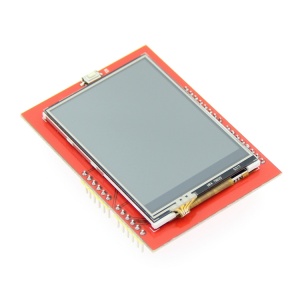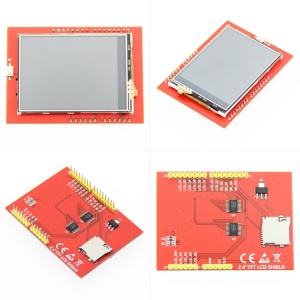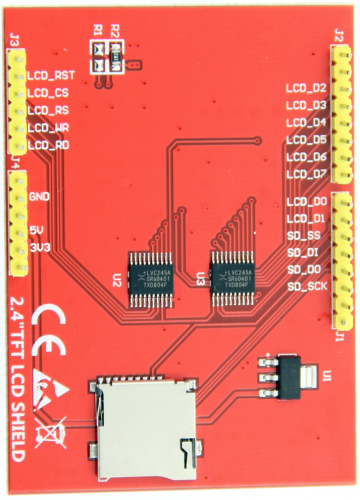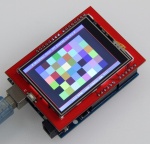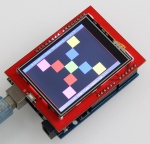Difference between revisions of "1.44inch Arduino SPI Module ST7735S SKU:MAR1441"
(Created page with "123") |
|||
| Line 1: | Line 1: | ||
| − | + | {{lan | |
| + | | | ||
| + | cn=http://www.lcdwiki.com/zh/1.44inch_Arduino_SPI_Module_ST7735S_SKU:MAR1441 | ||
| + | | | ||
| + | en=http://www.lcdwiki.com/1.44inch_Arduino_SPI_Module_ST7735S_SKU:MAR1441 | ||
| + | }} | ||
| + | |||
| + | |||
| + | == <font color="blue">Product Video</font> == | ||
| + | |||
| + | |||
| + | == <font color="blue">Product Picture</font> == | ||
| + | [[File:2.4-UNO-1.jpg|300px]] | ||
| + | [[File:2.4-UNO-2.jpg|300px]] | ||
| + | |||
| + | ==<font color="blue">Product Description</font> == | ||
| + | |||
| + | * Supports development boards such as Arduino UNO and Mega2560 for plug-in use without wiring | ||
| + | * 320X240 resolution, clear display, support for touch function | ||
| + | * Support 16-bit RGB 65K color display, display rich colors | ||
| + | * 8-bit parallel bus, faster than serial SPI refresh | ||
| + | * On-board 5V/3.3V level shifting IC, compatible with 5V/3.3V operating voltage | ||
| + | * Easy to expand the experiment with SD card slot | ||
| + | * Provides an Arduino library with a rich sample program | ||
| + | * Military-grade process standards, long-term stable work | ||
| + | * Provide underlying driver technical support | ||
| + | |||
| + | ==<font color="blue">Product Parameters</font> == | ||
| + | {| class="wikitable" border="1" style="width: 500px; background-color: white;" | ||
| + | | align="center" |Name | ||
| + | | align="center" |Parameter | ||
| + | |- | ||
| + | | align="center" |Display Color | ||
| + | | align="center" |RGB 65K color | ||
| + | |- | ||
| + | | align="center" |SKU | ||
| + | | align="center" |MAR2406 | ||
| + | |- | ||
| + | | align="center" |Screen Size | ||
| + | | align="center" |2.4(inch) | ||
| + | |- | ||
| + | | align="center" |Type | ||
| + | | align="center" |TFT | ||
| + | |- | ||
| + | | align="center" |Driver IC | ||
| + | | align="center" |ILI9341 | ||
| + | |- | ||
| + | | align="center" |Resolution | ||
| + | | align="center" |320*240 (Pixel) | ||
| + | |- | ||
| + | | align="center" |Module Interface | ||
| + | | align="center" |8-bit parallel interface | ||
| + | |- | ||
| + | | align="center" |Active Area | ||
| + | | align="center" |48.96*36.72(mm) | ||
| + | |- | ||
| + | | align="center" |Module PCB Size | ||
| + | | align="center" |72.20*52.7(mm) | ||
| + | |- | ||
| + | | align="center" |Operating Temperature | ||
| + | | align="center" | -20℃~70℃ | ||
| + | |- | ||
| + | | align="center" |Storage Temperature | ||
| + | | align="center" | -40℃~70℃ | ||
| + | |- | ||
| + | | align="center" |Operating Voltage | ||
| + | | align="center" |5V/3.3V | ||
| + | |- | ||
| + | | align="center" |Power Consumption | ||
| + | | align="center" |About 90mw | ||
| + | |- | ||
| + | | align="center" |Product Weight | ||
| + | | align="center" |About 25(g) | ||
| + | |} | ||
| + | |||
| + | ==<font color="blue">Interface Definition</font> == | ||
| + | [[file:MAR2406-007.png|left|500x500px]] | ||
| + | {| class="wikitable" border="1" style="width: 550px; background-color: white;" | ||
| + | |- | ||
| + | | align="center" |Number | ||
| + | | align="center" |Pin Label | ||
| + | | align="center" |Pin Description | ||
| + | |- | ||
| + | | align="center" |1 | ||
| + | | align="center" |LCD_RST | ||
| + | |LCD bus reset signal, low level reset | ||
| + | |- | ||
| + | | align="center" |2 | ||
| + | | align="center" |LCD_CS | ||
| + | |LCD bus chip select signal, low level enable | ||
| + | |- | ||
| + | | align="center" |3 | ||
| + | | align="center" |LCD_RS | ||
| + | |LCD bus command / data selection signal, | ||
| + | low level: command, high level: data | ||
| + | |- | ||
| + | | align="center" |4 | ||
| + | | align="center" |LCD_WR | ||
| + | |LCD bus write signal | ||
| + | |- | ||
| + | | align="center" |5 | ||
| + | | align="center" |LCD_RD | ||
| + | |LCD bus read signal | ||
| + | |- | ||
| + | | align="center" |6 | ||
| + | | align="center" |GND | ||
| + | |Power ground | ||
| + | |- | ||
| + | | align="center" |7 | ||
| + | | align="center" |5V | ||
| + | |5V power input | ||
| + | |- | ||
| + | | align="center" |8 | ||
| + | | align="center" |3V3 | ||
| + | |3.3V power input, this pin can be disconnected | ||
| + | |- | ||
| + | | align="center" |9 | ||
| + | | align="center" |LCD_D0 | ||
| + | |LCD 8-bit data Bit0 | ||
| + | |- | ||
| + | | align="center" |10 | ||
| + | | align="center" |LCD_D1 | ||
| + | |LCD 8-bit data Bit1 | ||
| + | |- | ||
| + | | align="center" |11 | ||
| + | | align="center" |LCD_D2 | ||
| + | |LCD 8-bit data Bit2 | ||
| + | |- | ||
| + | | align="center" |12 | ||
| + | | align="center" |LCD_D3 | ||
| + | |LCD 8-bit data Bit3 | ||
| + | |- | ||
| + | | align="center" |13 | ||
| + | | align="center" |LCD_D4 | ||
| + | |LCD 8-bit data Bit4 | ||
| + | |- | ||
| + | | align="center" |14 | ||
| + | | align="center" |LCD_D5 | ||
| + | |LCD 8-bit data Bit5 | ||
| + | |- | ||
| + | | align="center" |15 | ||
| + | | align="center" |LCD_D6 | ||
| + | |LCD 8-bit data Bit6 | ||
| + | |- | ||
| + | | align="center" |16 | ||
| + | | align="center" |LCD_D7 | ||
| + | |LCD 8-bit data Bit7 | ||
| + | |- | ||
| + | | align="center" |17 | ||
| + | | align="center" |SD_SS | ||
| + | |SD card SPI bus chip select signal, low level enable | ||
| + | |- | ||
| + | | align="center" |18 | ||
| + | | align="center" |SD_DI | ||
| + | |SD card SPI bus MOSI signal | ||
| + | |- | ||
| + | | align="center" |19 | ||
| + | | align="center" |SD_DO | ||
| + | |SD card SPI bus MISO signal | ||
| + | |- | ||
| + | | align="center" |20 | ||
| + | | align="center" |SD_SCK | ||
| + | |SD card SPI bus clock signal | ||
| + | |} | ||
| + | |||
| + | ==<font color="blue">Product Documentation</font> == | ||
| + | |||
| + | * [http://www.lcdwiki.com/res/MAR2406/2.4inch_Arduino_8BIT_Module_MAR2406_User_Manual_EN.pdf '''2.4 inch Arduino UNO Module User Manual'''] | ||
| + | * [http://www.lcdwiki.com/images/6/6f/2.4-UNO-size.jpg '''2.4 inch Arduino UNO Module Size Picture'''] | ||
| + | * [http://www.lcdwiki.com/res/MAR2406/QD243701%20specification_v1.1.pdf '''2.4 inch TFT Specifications'''] | ||
| + | * [http://www.lcdwiki.com/res/MAR2406/ILI9341_Datasheet.pdf '''Driver IC ILI9341 Data sheet'''] | ||
| + | |||
| + | ==<font color="blue">Connect to Arduino</font> == | ||
| + | |||
| + | {| class="FCK__ShowTableBorders" align="left" | ||
| + | |- | ||
| + | ![[file:MAR2406-004.jpg|无框|400x400px]] | ||
| + | ![[file:MAR2406-003.jpg|无框|400x400px]] | ||
| + | |- | ||
| + | | align="center" | '''Arduino UNO direct insertion picture''' | ||
| + | | align="center" | '''Arduino Mega2560 direct insertion picture''' | ||
| + | |} | ||
| + | <br clear="all"> | ||
| + | |||
| + | ==<font color="blue">How to use on Arduino</font> == | ||
| + | *'''Step 1: Download the test program''' | ||
| + | |||
| + | # Download the Arduino test program from the [[#Program Download|'''Program Download''']] column | ||
| + | # For a description of the relevant test procedures, please refer to the test program documentation in the package | ||
| + | |||
| + | *'''Step 2: Connect the Arduino development board''' | ||
| + | |||
| + | # Plug the module directly into the Arduino development board ([[#Connect to Arduino| <font color="red"> '''Do not plug in?'''</font>]]) | ||
| + | # After the module is plugged in, power on the Arduino board | ||
| + | |||
| + | *'''Step 3: Copy the dependent library''' | ||
| + | |||
| + | # Make sure the Arduino IDE is installed on your computer (if it is not installed: [https://www.arduino.cc/en/Main/Software '''Arduino IDE download URL''']) | ||
| + | # After installing the Arduino IDE, you need to copy the dependent library to the Arduino project directory as follows: | ||
| + | |||
| + | ::(1) Decompress the downloaded test package | ||
| + | ::(2) Copy the dependent libraries in the <font color="red"> '''Install libraries'''</font> directory in the package (shown below) to the <font color="red">'''libraries'''</font> folder | ||
| + | :::of the Arduino project directory ([http://www.lcdwiki.com/res/PublicFile/Arduino_IDE_Use_Illustration_EN.pdf <font color="red"> '''Don't know the Arduino project directory?'''</font>]) | ||
| + | ::[[File:MAR2406-005.jpg|500px]] | ||
| + | |||
| + | *'''Step 4: Compile and download the program to the development board''' | ||
| + | |||
| + | # Open the sample in the Example directory of the package to test, compile and download([http://www.lcdwiki.com/res/PublicFile/Arduino_IDE_Use_Illustration_EN.pdf <font color="red"> '''Don't know how to compile and download?'''</font>]) | ||
| + | |||
| + | *'''Step 5: Observe the running of the program''' | ||
| + | |||
| + | # After the program is downloaded, run it directly and observe the running status. If it can be displayed normally, the program runs | ||
| + | ::successfully, as shown in the following figure (take the colligate_test test program as an example): | ||
| + | |||
| + | ::[[File:MAR2406-001.jpg|150px]] [[File:MAR2406-002.jpg|150px]] | ||
| + | |||
| + | ==<font color="blue">Program Download</font> == | ||
| + | |||
| + | # [https://yunpan.360.cn/surl_ymIbLShdqu7 '''Demo_Arduino_8BIT'''] | ||
| + | # [https://yunpan.360.cn/surl_ymIC9zbMDD2 '''Demo_STC12C5A60S2_8BIT'''] | ||
| + | # [https://yunpan.360.cn/surl_ymICzKxnsnQ '''Demo_STM32F103RCT6_8BIT'''] | ||
| + | # [https://yunpan.360.cn/surl_ymICpjIDEJc '''Demo_STM32F103ZET6_8BIT'''] | ||
| + | # [https://yunpan.360.cn/surl_ymIC4JfmLR7 '''Demo_STM32F407ZGT6_8BIT'''] | ||
| + | # [https://yunpan.360.cn/surl_ymIC4T89TDj '''Demo_STM32F429IGT6_8BIT'''] | ||
| + | |||
| + | * [https://yunpan.360.cn/surl_ymICNUCtuMX '''2.4 inch Arduino UNO module package(The above program is packaged with one click download)'''] | ||
| + | |||
| + | ==<font color="blue">Reference Materials</font> == | ||
| + | |||
| + | * [http://www.lcdwiki.com/res/PublicFile/Arduino_IDE_Use_Illustration_EN.pdf '''Arduino IDE software use illustration'''] | ||
| + | * [http://www.lcdwiki.com/res/PublicFile/C51_Keil%26stc-isp_Use_Illustration_EN.pdf '''C51 Keil and stc-isp software use illustration'''] | ||
| + | * [http://www.lcdwiki.com/res/PublicFile/STM32_Keil_Use_Illustration_EN.pdf '''STM32 keil software use illustration'''] | ||
| + | * [http://www.lcdwiki.com/res/PublicFile/PCtoLCD2002_Use_Illustration_EN.pdf '''PCtoLCD2002 software use illustration'''] | ||
| + | * [http://www.lcdwiki.com/res/PublicFile/Image2Lcd_Use_Illustration_EN.pdf '''Image2Lcd software use illustration'''] | ||
| + | * [http://www.lcdwiki.com/Chinese_and_English_display_modulo_settings '''Chinese and English display modulo settings'''] | ||
| + | |||
| + | ==<font color="blue">Common Software</font> == | ||
| + | |||
| + | * [http://www.lcdwiki.com/res/software/PCtoLCD2002.zip '''PCtoLCD2002'''] | ||
| + | * [http://www.lcdwiki.com/res/software/Image2Lcd.zip '''Image2Lcd'''] | ||
| + | |||
| + | [[#top|BACK TO TOP]] | ||
Revision as of 10:37, 14 December 2018
Contents
Product Video
Product Picture
Product Description
- Supports development boards such as Arduino UNO and Mega2560 for plug-in use without wiring
- 320X240 resolution, clear display, support for touch function
- Support 16-bit RGB 65K color display, display rich colors
- 8-bit parallel bus, faster than serial SPI refresh
- On-board 5V/3.3V level shifting IC, compatible with 5V/3.3V operating voltage
- Easy to expand the experiment with SD card slot
- Provides an Arduino library with a rich sample program
- Military-grade process standards, long-term stable work
- Provide underlying driver technical support
Product Parameters
| Name | Parameter |
| Display Color | RGB 65K color |
| SKU | MAR2406 |
| Screen Size | 2.4(inch) |
| Type | TFT |
| Driver IC | ILI9341 |
| Resolution | 320*240 (Pixel) |
| Module Interface | 8-bit parallel interface |
| Active Area | 48.96*36.72(mm) |
| Module PCB Size | 72.20*52.7(mm) |
| Operating Temperature | -20℃~70℃ |
| Storage Temperature | -40℃~70℃ |
| Operating Voltage | 5V/3.3V |
| Power Consumption | About 90mw |
| Product Weight | About 25(g) |
Interface Definition
| Number | Pin Label | Pin Description |
| 1 | LCD_RST | LCD bus reset signal, low level reset |
| 2 | LCD_CS | LCD bus chip select signal, low level enable |
| 3 | LCD_RS | LCD bus command / data selection signal,
low level: command, high level: data |
| 4 | LCD_WR | LCD bus write signal |
| 5 | LCD_RD | LCD bus read signal |
| 6 | GND | Power ground |
| 7 | 5V | 5V power input |
| 8 | 3V3 | 3.3V power input, this pin can be disconnected |
| 9 | LCD_D0 | LCD 8-bit data Bit0 |
| 10 | LCD_D1 | LCD 8-bit data Bit1 |
| 11 | LCD_D2 | LCD 8-bit data Bit2 |
| 12 | LCD_D3 | LCD 8-bit data Bit3 |
| 13 | LCD_D4 | LCD 8-bit data Bit4 |
| 14 | LCD_D5 | LCD 8-bit data Bit5 |
| 15 | LCD_D6 | LCD 8-bit data Bit6 |
| 16 | LCD_D7 | LCD 8-bit data Bit7 |
| 17 | SD_SS | SD card SPI bus chip select signal, low level enable |
| 18 | SD_DI | SD card SPI bus MOSI signal |
| 19 | SD_DO | SD card SPI bus MISO signal |
| 20 | SD_SCK | SD card SPI bus clock signal |
Product Documentation
- 2.4 inch Arduino UNO Module User Manual
- 2.4 inch Arduino UNO Module Size Picture
- 2.4 inch TFT Specifications
- Driver IC ILI9341 Data sheet
Connect to Arduino
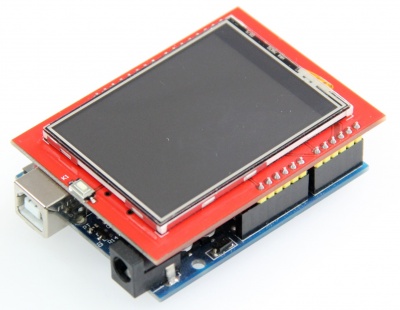
|
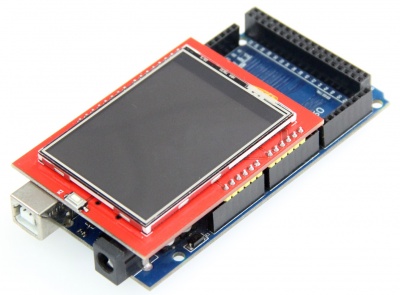
|
|---|---|
| Arduino UNO direct insertion picture | Arduino Mega2560 direct insertion picture |
How to use on Arduino
- Step 1: Download the test program
- Download the Arduino test program from the Program Download column
- For a description of the relevant test procedures, please refer to the test program documentation in the package
- Step 2: Connect the Arduino development board
- Plug the module directly into the Arduino development board ( Do not plug in?)
- After the module is plugged in, power on the Arduino board
- Step 3: Copy the dependent library
- Make sure the Arduino IDE is installed on your computer (if it is not installed: Arduino IDE download URL)
- After installing the Arduino IDE, you need to copy the dependent library to the Arduino project directory as follows:
- (1) Decompress the downloaded test package
- (2) Copy the dependent libraries in the Install libraries directory in the package (shown below) to the libraries folder
- of the Arduino project directory ( Don't know the Arduino project directory?)

- Step 4: Compile and download the program to the development board
- Open the sample in the Example directory of the package to test, compile and download( Don't know how to compile and download?)
- Step 5: Observe the running of the program
- After the program is downloaded, run it directly and observe the running status. If it can be displayed normally, the program runs
- successfully, as shown in the following figure (take the colligate_test test program as an example):
Program Download
- Demo_Arduino_8BIT
- Demo_STC12C5A60S2_8BIT
- Demo_STM32F103RCT6_8BIT
- Demo_STM32F103ZET6_8BIT
- Demo_STM32F407ZGT6_8BIT
- Demo_STM32F429IGT6_8BIT
Reference Materials
- Arduino IDE software use illustration
- C51 Keil and stc-isp software use illustration
- STM32 keil software use illustration
- PCtoLCD2002 software use illustration
- Image2Lcd software use illustration
- Chinese and English display modulo settings
